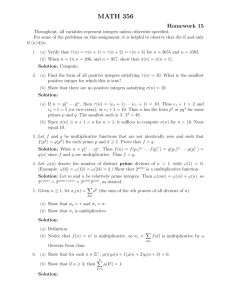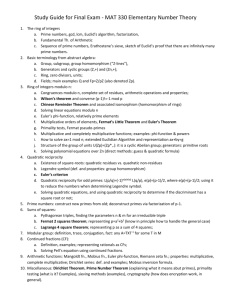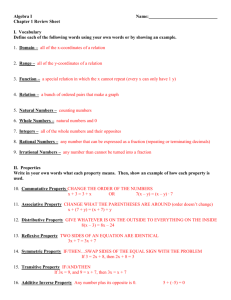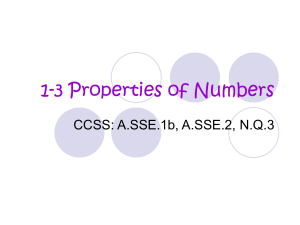MULTIPLICATIVE FUNCTIONS: A REWRITE OF ANDREWS
advertisement
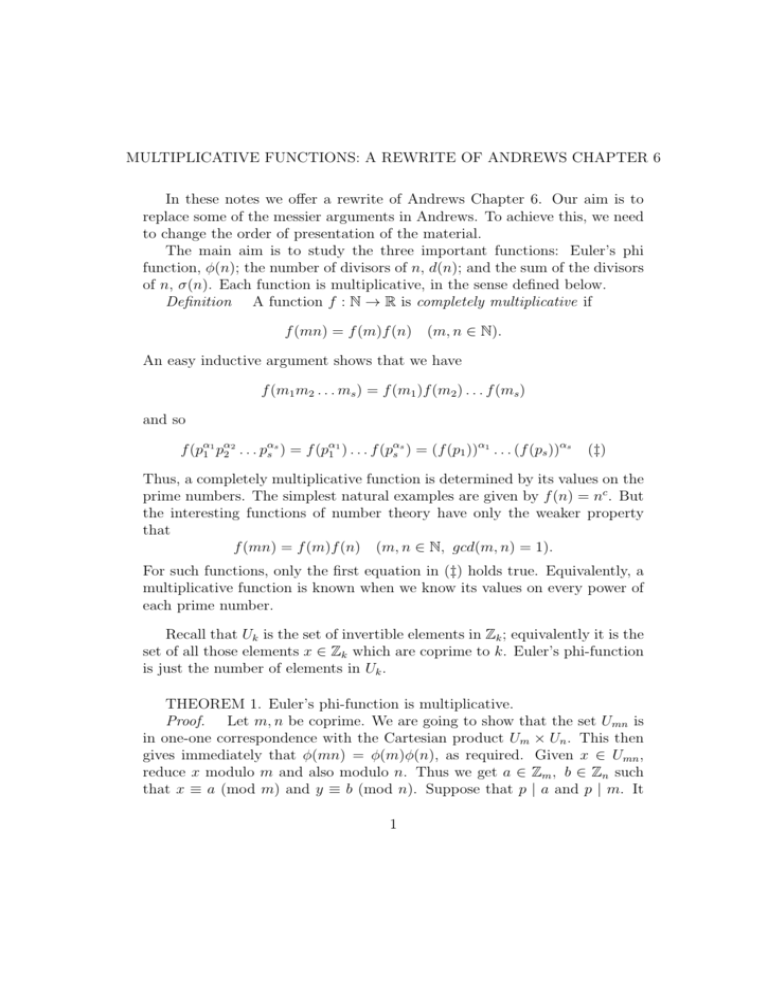
MULTIPLICATIVE FUNCTIONS: A REWRITE OF ANDREWS CHAPTER 6 In these notes we offer a rewrite of Andrews Chapter 6. Our aim is to replace some of the messier arguments in Andrews. To achieve this, we need to change the order of presentation of the material. The main aim is to study the three important functions: Euler’s phi function, ϕ(n); the number of divisors of n, d(n); and the sum of the divisors of n, σ(n). Each function is multiplicative, in the sense defined below. Definition A function f : N → R is completely multiplicative if f (mn) = f (m)f (n) (m, n ∈ N). An easy inductive argument shows that we have f (m1 m2 . . . ms ) = f (m1 )f (m2 ) . . . f (ms ) and so f (pα1 1 pα2 2 . . . pαs s ) = f (pα1 1 ) . . . f (pαs s ) = (f (p1 ))α1 . . . (f (ps ))αs (‡) Thus, a completely multiplicative function is determined by its values on the prime numbers. The simplest natural examples are given by f (n) = nc . But the interesting functions of number theory have only the weaker property that f (mn) = f (m)f (n) (m, n ∈ N, gcd(m, n) = 1). For such functions, only the first equation in (‡) holds true. Equivalently, a multiplicative function is known when we know its values on every power of each prime number. Recall that Uk is the set of invertible elements in Zk ; equivalently it is the set of all those elements x ∈ Zk which are coprime to k. Euler’s phi-function is just the number of elements in Uk . THEOREM 1. Euler’s phi-function is multiplicative. Proof. Let m, n be coprime. We are going to show that the set Umn is in one-one correspondence with the Cartesian product Um × Un . This then gives immediately that ϕ(mn) = ϕ(m)ϕ(n), as required. Given x ∈ Umn , reduce x modulo m and also modulo n. Thus we get a ∈ Zm , b ∈ Zn such that x ≡ a (mod m) and y ≡ b (mod n). Suppose that p | a and p | m. It 1 follows that p | x, and also p | mn. Since x ∈ Umn , we must have p = 1 and so a ∈ Um . Similarly, b ∈ Un . So we get a function F : Umn → Um × Un defined by F (x) = (a, b). It remains to show that F is one-one and onto. To see that F is one-one, suppose that F (x) = F (y) with x, y ∈ Umn . Then x≡a≡y x≡b≡y (mod m), (mod n). This gives m | (x − y) and n | (x − y). But m, n are coprime, and so mn | (x − y), that is, x = y. To see that F is onto, take any a ∈ Um and any b ∈ Un . By the Chinese Remainder Theorem, there exists x ∈ Zmn such that x ≡ a (mod m) and x ≡ b (mod n). To see that x ∈ Umn , suppose that a prime p divides both x and mn. But then p divides either m or n, which contradicts the fact that a ∈ Um and b ∈ Un . Thus x ∈ Umn and we have F (x) = (a, b). So F is onto, and the proof is complete. We can now get the formula for ϕ(n). For n = pα , we see that the only elements not coprime to n are 0, p, 2p, . . . p2 , p2 + p, . . . pα − p and so ϕ(pα ) = pα − pα−1 . Since ϕ is multiplicative, we get ( ) ) ∏ ∏ ∏( 1 αi αi αi −1 ϕ(n) = ϕ pi = (pi − pi ) = n 1− . pi i i i The last product above gives the fraction of n for which the numbers are coprime to n. When n is a large prime, this fraction is very nearly 1. When n is the product of the first k primes, then the fraction goes to zero as k goes to infinity. This last assertion is by no means obvious, ∑ but it corresponds to the fact (to be proved later) that the infinite series (1/pi ) diverges. 2 We are now going to see how to build a new multiplicative function from an old one. As an immediate corollary we shall see that our other two functions d(n) and σ(n) are also multiplicative. THEOREM 2. Let f be multiplicative and let ∑ F (n) = f (k). k|n Then F is multiplicative. Proof. Let m, n be coprime, and let k | mn. By the Fundamental Theorem of Arithmetic, k = ab where a | m, b | n and a, b are coprime. Conversely, each such choice of a, b gives a product ab which is a factor of mn. Hence, ∑ ∑ ∑ ∑ ∑ f (b) = F (m)F (n). f (a) f (a)f (b) = f (ab) = f (k) = F (mn) = k|mn a|m,b|n a|m,b|n a|m b|n Take f (n) = 1 (which is completely multiplicative) and we see that d(n) is multiplicative. Take f (n) = n (which is also completely multiplicative) and we see that σ(n) is also multiplicative. To get the formulas for d(n) and σ(n), we just have to calculate that d(pα ) = α + 1 and σ(pα ) = 1 + p + p2 + · · · + pα = pα+1)−1 . p−1 As another application of Theorem 2, take f = ϕ and we claim that the associated function F is given by F (n) = n. To get this, we just have to show that F (pα ) = pα . But F (pα ) = ϕ(1)+ϕ(p)+ϕ(p2 )+· · ·+ϕ(pα ) = 1+(p−1)+(p2 −p)+· · ·+(pα −pα−1 = pα as required. We find below another way to get the same result. Our final special function is a very curious one, called the Möbius function, denoted by µ(n). We let µ(1) = 1, µ(p1 p2 . . . ps ) = (−1)s , and µ(n) = 0 otherwise, that is, if n has at least one repeated prime factor. It is routine by 3 case-checking to see that µ(n) is also multiplicative. Apply Theorem 2 with f = µ to get associated multiplicative function M (n). Clearly M (1) = 1 and M (pα ) = µ(1) + µ(p) + µ(p2 ) + · · · + µ(pα ) = 1 − 1 + 0 + · · · + 0 = 0. It follows that M (n) = 0 whenever n > 1, in other words, ∑ µ(k) = 0 (n > 1). k|n The next theorem is called the Möbius Inversion Theorem. Since summation corresponds to integration and differences (here with spacing h = 1) correspond to derivatives, you may think of the theorem as a discrete version of the Fundamental Theorem of Calculus. THEOREM 3. Let f, g be any (real) functions on N. Then ∑ g(k) (n ∈ N) (∗) f (n) = k|n if and only if g(n) = ∑ µ(k)f (n/k) (n ∈ N) (∗∗). k|n Proof. Suppose that (∗) holds. Then ∑ ∑ ∑ ∑ ∑ ∑ g(e) µ(j). µ(k)g(e) = µ(k) g(e) = µ(k)f (n/k) = k|n kk′ =n e|k′ keh=n ee′ =n j|e′ From above, the inner summation in the last equation is zero except when e′ = 1 and so e = n. Thus the sum is f (n), as required. The other half of the proof is similar. A pair of functions (f, g) satisfying either of the equivalent conditions (∗) or (∗∗) is called a Möbius pair. Thus (n, ϕ), (d, 1), (σ, n) are all Möbius pairs. So also is (µ, δ), where δ is the Dirac delta function which is 1 at 1 and zero elsewhere. Our final theorem is about the multiplicative properties of a Möbius pair. We have already proved one half of it. The other half is similar and is left to the reader. 4 THEOREM 4. Let (f, g) be a Möbius pair. Then f is multiplicative if and only if g is multiplicative. When we invert the Möbius pair (n, ϕ), we get the formula ∑ n ϕ(n) = µ(k) . k k|n Of course this is easy to check when n = pα . It is tempting to think that we now have a quick proof that ϕ is multiplicative. Unfortunately this is not the case, since we would need to check that one of the Möbius pair equations holds for all n. Remark. In combinatorics, the Möbius Inversion Theorem has been generalized by replacing N by certain partially ordered spaces. 5




